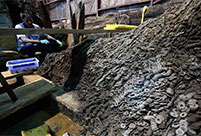

 |
| (Photo/Xinhua) |
A research group of the medical school at Nankai University recently discovered a type of protein coil domain containing protein 8 (CCDC8), which has high anti-HIV-1 activity, and may be able to greatly slow down the virus production. This discovery points in a new direction for anti-AIDS drugs.
Normally, after the human body is infected with HIV, the virus soon invades human cells, quickly replicating and releasing outside of cells. Under the “direction” of the viral genome, host cells turn into a structural protein in cytoplasm called “Gag” during the process. Gag is the main building material for the HIV virus structure. Gag gathers on the cytomembrane and forms polymers to “bud” outside of the cell. Eventually the semi-finished virus departs the host cell and turns into a whole virus particle.
However, the research team discovered that when Gag meets CCDC8, its assembly process was hindered. In addition, CCDC8 combines with other proteins like Obs11 and Cu17 to degrade Gag and stop it from budding, which can help control patients’ disease.
“CCDC8 exists on human cytomembrane. Its small quantity has difficulty preventing the HIV virus from replicating. We use the technique of foreign gene delivery and expression, which greatly improved the amount of CCDC8, and its activity against the HIV virus had an obvious upgrade as well. We believe CCDC8 can be a new direction for anti-AIDS drugs,” said Wei Min, professor of the research team at Nankai University.
 Contestants of Mrs. Globe pose for photo in Shenzhen
Contestants of Mrs. Globe pose for photo in Shenzhen
 Bikini models attend hot pot banquet in Hefei
Bikini models attend hot pot banquet in Hefei J-10B fighters with homegrown engine in test fligh
J-10B fighters with homegrown engine in test fligh Photos of U.S. Navy intruding in South China Sea released
Photos of U.S. Navy intruding in South China Sea released Cats who immediately regretted their life choices in photographs
Cats who immediately regretted their life choices in photographs Beautiful girl from police college becomes Internet hit
Beautiful girl from police college becomes Internet hit 10 tons of copper coins unearthed in 2,000-yr old tomb
10 tons of copper coins unearthed in 2,000-yr old tomb In Pics: Amazing Chinese fighters
In Pics: Amazing Chinese fighters
 Chinese, U.S. navies hold first-ever joint exercise in the Atlantic
Chinese, U.S. navies hold first-ever joint exercise in the Atlantic Top 20 hottest women in the world in 2014
Top 20 hottest women in the world in 2014 Top 10 hardest languages to learn
Top 10 hardest languages to learn 10 Chinese female stars with most beautiful faces
10 Chinese female stars with most beautiful faces China’s Top 10 Unique Bridges, Highways and Roads
China’s Top 10 Unique Bridges, Highways and RoadsDay|Week